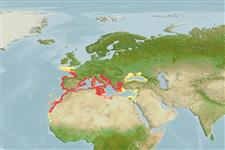Environment: milieu / climate zone / depth range / distribution range
ນິເວດວິທະຍາ
ສັດທະເລ; ນ້ຳກ່ອຍ; ປາທີ່ມີການເຄື່ອນຍ້າຍໃນສະເພາະມາະຫາສະມຸດ (Ref. 51243); ລະດັບຄວາມເລິກ 0 - 500 m, usually 5 - 250 m (Ref. 54928). Subtropical; 50°N - 16°N, 20°W - 43°E
Eastern Atlantic: Bay of Biscay to Mauritania including the Mediterranean Sea. The subspecies Trachurus mediterraneus ponticus occurs in the Marmara and Black seas, southern and western parts of the Azov Sea.
Length at first maturity / ຂະໜາດ / ນ້ຳໜັກ / Age
Maturity: Lm 20.0 range ? - ? cm
Max length : 60.0 cm FL ຕົວຜູ້/ບໍ່ມີເພດ; (Ref. 3397); common length : 30.0 cm FL ຕົວຜູ້/ບໍ່ມີເພດ; (Ref. 3397)
Adults are found usually near the bottom, at times also in surface waters; pelagic and migratory in large schools. They feed on other fishes especially sardines, anchovies, etc. and small crustaceans (Ref. 4233). Eggs are pelagic (Ref. 4233).
Smith-Vaniz, W.F., 1986. Carangidae. p. 815-844. In P.J.P. Whitehead, M.-L. Bauchot, J.-C. Hureau, J. Nielsen and E. Tortonese (eds.) Fishes of the north-eastern Atlantic and the Mediterranean. UNESCO, Paris. vol. 2. (Ref. 4233)
IUCN Red List Status (Ref. 130435)
Threat to humans
Harmless
Human uses
ການປະມົງ: ເປັນສີນຄ້າ; ຊະນິດປາທີ່ຖືກນຳໃຊ້ເຂົ້າໃນການຫາເພື່ອເປັນເກມກິລາ: ແມ່ນ
ເຄື່ອງມື
Special reports
Download XML
ແຫຼ່ງອີນເຕີເນັດ
Estimates based on models
Preferred temperature (Ref.
123201): 13.2 - 21, mean 17.4 °C (based on 748 cells).
Phylogenetic diversity index (Ref.
82804): PD
50 = 0.5001 [Uniqueness, from 0.5 = low to 2.0 = high].
Bayesian length-weight: a=0.00891 (0.00773 - 0.01028), b=2.96 (2.93 - 2.99), in cm total length, based on LWR estimates for this species (Ref.
93245).
ຊັ້ນເຂດຮ້ອນ (Ref.
69278): 3.8 ±0.3 se; based on diet studies.
ຄວາມຢືດຢຸ່ນ (Ref.
120179): ຂະໜາດກາງ, ປະຊາກອນຕຳ່ສຸດທີ່ໃຊ້ເວລາສອງເທົ່າ 1.4 - 4.4 ປີ (K=0.22; tmax=12).
Prior r = 0.51, 95% CL = 0.33 - 0.76, Based on 5 stock assessments.
Fishing Vulnerability (Ref.
59153): Moderate vulnerability (36 of 100).
Climate Vulnerability (Ref.
125649): Moderate to high vulnerability (50 of 100).
Nutrients (Ref.
124155): Calcium = 215 [146, 344] mg/100g; Iron = 3.76 [2.38, 6.28] mg/100g; Protein = 19.8 [19.1, 20.4] %; Omega3 = 0.38 [0.27, 0.54] g/100g; Selenium = 26 [17, 40] μg/100g; VitaminA = 13.8 [3.7, 48.1] μg/100g; Zinc = 1.94 [1.49, 2.61] mg/100g (wet weight); based on
nutrient studies.
